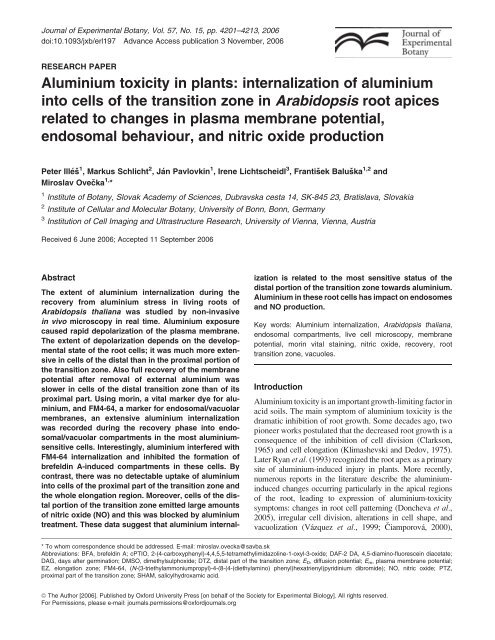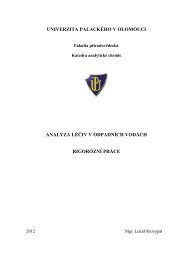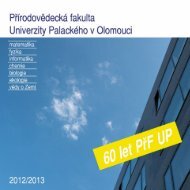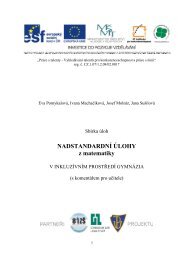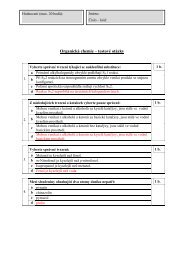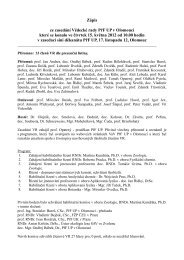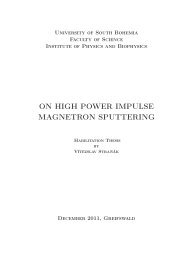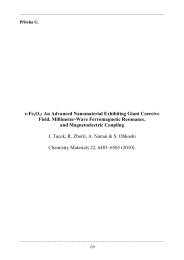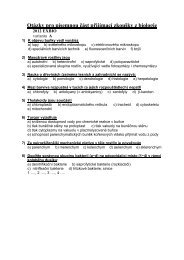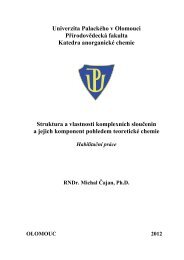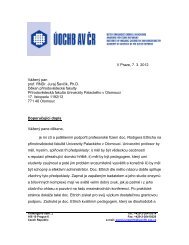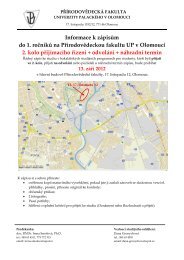A comparative structural analysis of direct and indirect shoot ...
A comparative structural analysis of direct and indirect shoot ...
A comparative structural analysis of direct and indirect shoot ...
You also want an ePaper? Increase the reach of your titles
YUMPU automatically turns print PDFs into web optimized ePapers that Google loves.
Journal <strong>of</strong> Experimental Botany, Vol. 57, No. 15, pp. 4201–4213, 2006<br />
doi:10.1093/jxb/erl197 Advance Access publication 3 November, 2006<br />
RESEARCH PAPER<br />
Aluminium toxicity in plants: internalization <strong>of</strong> aluminium<br />
into cells <strong>of</strong> the transition zone in Arabidopsis root apices<br />
related to changes in plasma membrane potential,<br />
endosomal behaviour, <strong>and</strong> nitric oxide production<br />
Peter Illéš 1 , Markus Schlicht 2 ,Ján Pavlovkin 1 , Irene Lichtscheidl 3 , František Baluška 1,2 <strong>and</strong><br />
Miroslav Ovečka 1, *<br />
1 Institute <strong>of</strong> Botany, Slovak Academy <strong>of</strong> Sciences, Dubravska cesta 14, SK-845 23, Bratislava, Slovakia<br />
2 Institute <strong>of</strong> Cellular <strong>and</strong> Molecular Botany, University <strong>of</strong> Bonn, Bonn, Germany<br />
3 Institution <strong>of</strong> Cell Imaging <strong>and</strong> Ultrastructure Research, University <strong>of</strong> Vienna, Vienna, Austria<br />
Received 6 June 2006; Accepted 11 September 2006<br />
Abstract<br />
The extent <strong>of</strong> aluminium internalization during the<br />
recovery from aluminium stress in living roots <strong>of</strong><br />
Arabidopsis thaliana was studied by non-invasive<br />
in vivo microscopy in real time. Aluminium exposure<br />
caused rapid depolarization <strong>of</strong> the plasma membrane.<br />
The extent <strong>of</strong> depolarization depends on the developmental<br />
state <strong>of</strong> the root cells; it was much more extensive<br />
in cells <strong>of</strong> the distal than in the proximal portion <strong>of</strong><br />
the transition zone. Also full recovery <strong>of</strong> the membrane<br />
potential after removal <strong>of</strong> external aluminium was<br />
slower in cells <strong>of</strong> the distal transition zone than <strong>of</strong> its<br />
proximal part. Using morin, a vital marker dye for aluminium,<br />
<strong>and</strong> FM4-64, a marker for endosomal/vacuolar<br />
membranes, an extensive aluminium internalization<br />
was recorded during the recovery phase into endosomal/vacuolar<br />
compartments in the most aluminiumsensitive<br />
cells. Interestingly, aluminium interfered with<br />
FM4-64 internalization <strong>and</strong> inhibited the formation <strong>of</strong><br />
brefeldin A-induced compartments in these cells. By<br />
contrast, there was no detectable uptake <strong>of</strong> aluminium<br />
into cells <strong>of</strong> the proximal part <strong>of</strong> the transition zone <strong>and</strong><br />
the whole elongation region. Moreover, cells <strong>of</strong> the distal<br />
portion <strong>of</strong> the transition zone emitted large amounts<br />
<strong>of</strong> nitric oxide (NO) <strong>and</strong> this was blocked by aluminium<br />
treatment. These data suggest that aluminium internalization<br />
is related to the most sensitive status <strong>of</strong> the<br />
distal portion <strong>of</strong> the transition zone towards aluminium.<br />
Aluminium in these root cells has impact on endosomes<br />
<strong>and</strong> NO production.<br />
Key words: Aluminium internalization, Arabidopsis thaliana,<br />
endosomal compartments, live cell microscopy, membrane<br />
potential, morin vital staining, nitric oxide, recovery, root<br />
transition zone, vacuoles.<br />
Introduction<br />
Aluminium toxicity is an important growth-limiting factor in<br />
acid soils. The main symptom <strong>of</strong> aluminium toxicity is the<br />
dramatic inhibition <strong>of</strong> root growth. Some decades ago, two<br />
pioneer works postulated that the decreased root growth is a<br />
consequence <strong>of</strong> the inhibition <strong>of</strong> cell division (Clarkson,<br />
1965) <strong>and</strong> cell elongation (Klimashevski <strong>and</strong> Dedov, 1975).<br />
Later Ryan et al. (1993) recognized the root apex as a primary<br />
site <strong>of</strong> aluminium-induced injury in plants. More recently,<br />
numerous reports in the literature describe the aluminiuminduced<br />
changes occurring particularly in the apical regions<br />
<strong>of</strong> the root, leading to expression <strong>of</strong> aluminium-toxicity<br />
symptoms: changes in root cell patterning (Doncheva et al.,<br />
2005), irregular cell division, alterations in cell shape, <strong>and</strong><br />
vacuolization (Vázquez et al., 1999; Čiamporová, 2000),<br />
* To whom correspondence should be addressed. E-mail: miroslav.ovecka@savba.sk<br />
Abbreviations: BFA, brefeldin A; cPTIO, 2-(4-carboxyphenyl)-4,4,5,5-tetramethylimidazoline-1-oxyl-3-oxide; DAF-2 DA, 4,5-diamino-fluorescein diacetate;<br />
DAG, days after germination; DMSO, dimethylsulphoxide; DTZ, distal part <strong>of</strong> the transition zone; E D , diffusion potential; E m , plasma membrane potential;<br />
EZ, elongation zone; FM4-64, (N-(3-triethylammoniumpropyl)-4-(8-(4-(diethylamino) phenyl)hexatrienyl)pyridinium dibromide); NO, nitric oxide; PTZ,<br />
proximal part <strong>of</strong> the transition zone; SHAM, salicylhydroxamic acid.<br />
ª The Author [2006]. Published by Oxford University Press [on behalf <strong>of</strong> the Society for Experimental Biology]. All rights reserved.<br />
For Permissions, please e-mail: journals.permissions@oxfordjournals.org


